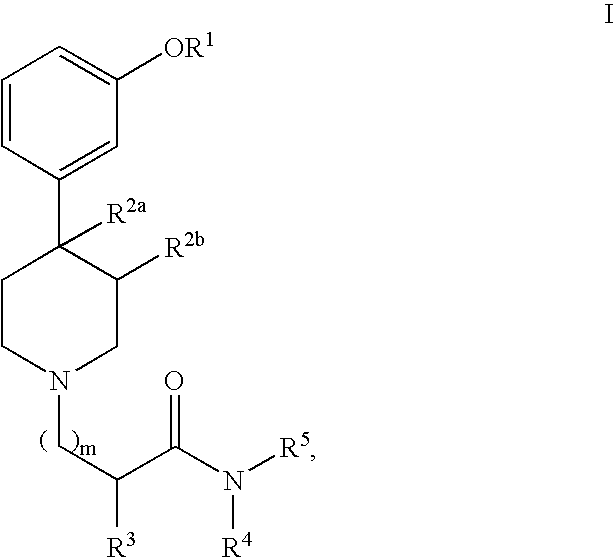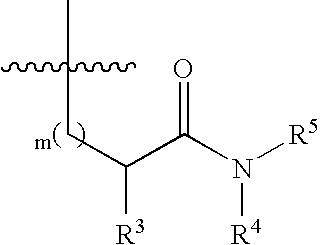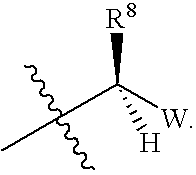Substituted piperidine compounds and methods of their use
a piperidine and substitute technology, applied in the field of compounds, can solve the problems of side effects, intestinal dysfunction, and opioid agonists
- Summary
- Abstract
- Description
- Claims
- Application Information
AI Technical Summary
Benefits of technology
Problems solved by technology
Method used
Image
Examples
example 1
2(S)-{2(S)-Benzyl-3-[4(R)-(3-hydroxy-phenyl)-3(R),4-dimethyl-piperidin-1-yl]-propionylamino}-3-phenyl-propionic acid (5a)
[0230]A solution dimethylformamide / piperidine 20:80 (20 mL) was added to the Fmoc-Phe Wang resin 1a (0.8 mmol / g, 0.250 g, 0.0002 mol) and the suspension was mixed at room temperature for 20 minutes (Scheme 1). The resin was then drained, washed consecutively with dimethylformamide (5×), dimethylformamide / water (9:1) (5×), dimethylformamide (5×), methanol (5×), dichloromethane (5×), diethyl ether (5×) and dried under vacuum. To a suspension of the resulting resin 2a in a mixture dichloromethane / dimethylformamide 1:1 (20 mL) was added consecutively diisopropylethylamine (0.036 mL, 0.00021 mol, 1.05 eq), carboxylic acid 3 (0.081 g, 0.00021 mol, 1.05 eq), and HATU (0.080 g, 0.00021 mol, 1.05 eq). The mixture was shaken for 3 h at room temperature. The resin was then drained, washed consecutively with dimethylformamide (5×), dimethylformamide / water(9:1) (5×), dimethylf...
example 2
2(S)-{3-[4(R)-(3-Hydroxy-phenyl)-3(R),4-dimethyl-piperidin-1-yl]-propionylamino}-3-phenyl-propionic acid (9a)
Preparation of carboxylic acid derivative 7:
[0231]A 1N solution of aqueous sodium hydroxide (58.2 mL, 0.05821 mol, 3 eq) was added drop wise to a cold (0° C.) solution of 6 (5.65 g, 0.01940 mol, 1 eq) in tetrahydrofuran (100 mL). The mixture was allowed to warm to room temperature and stirring was continued for 16h at room temperature. A 12N aqueous HCl solution (4.85 mL, 0.0582 mol, 3 eq) was added to neutralize the mixture that was concentrated under vacuum. The resulting solid was suspended in a mixture dichloromethane / MeOH 98:2. The mixture was filtered and the filtrate was evaporated to afford the desired compound 7 (3.7 g, 69%) used for the next step without further purification. Mass spectral analysis: m / z=278 (M+H)+.
[0232]To a suspension of the resin 2a (preparation described in example 1) in a mixture dichloromethane / dimethylformamide 1:1 (20 mL) was added consecutiv...
example 3
2(S)-[{3-[4(R)-(3-Hydroxy-phenyl)-3(R),4-dimethyl-piperidin-1-yl]-propionyl}-(4-methoxy-benzyl)-aminol-3-phenyl-propionic acid (14a)
[0233]To the resin 2a (0.00015 mol) swelled in trimethylorthoformate (6 mL) was added 4-methoxybenzaldehyde (0.408 g, 0.003 mol, 20 eq) and the reaction was mixed at room temperature for 30 min. Sodium cyanoborohydride (0.19 0 g, 0.003 mol, 20 eq) dispersed in trimethylorthoformate (3 mL) was added followed by acetic acid (0.032 mL), and the reaction mixture was mixed for an additional 10 min at room temperature. The reaction was filtered and the resin was washed with dimethylformamide (5×), methanol (5×), dichloromethane / triethylamine 9:1 (5×), methanol (5×), dichloromethane (5×), methanol (5×), diethyl ether (5×) and dried under vacuum. To a suspension of the resin 10a obtained previously in dichloromethane (20 mL) was added triethylamine (2.1 mL, 0.0015 mol, 10 eq) followed by acryloyl chloride (0.12 mL, 0.0015 mol, 10 eq). The mixture was shaken at ...
PUM
| Property | Measurement | Unit |
|---|---|---|
| Volume | aaaaa | aaaaa |
Abstract
Description
Claims
Application Information
 Login to View More
Login to View More - R&D
- Intellectual Property
- Life Sciences
- Materials
- Tech Scout
- Unparalleled Data Quality
- Higher Quality Content
- 60% Fewer Hallucinations
Browse by: Latest US Patents, China's latest patents, Technical Efficacy Thesaurus, Application Domain, Technology Topic, Popular Technical Reports.
© 2025 PatSnap. All rights reserved.Legal|Privacy policy|Modern Slavery Act Transparency Statement|Sitemap|About US| Contact US: help@patsnap.com



